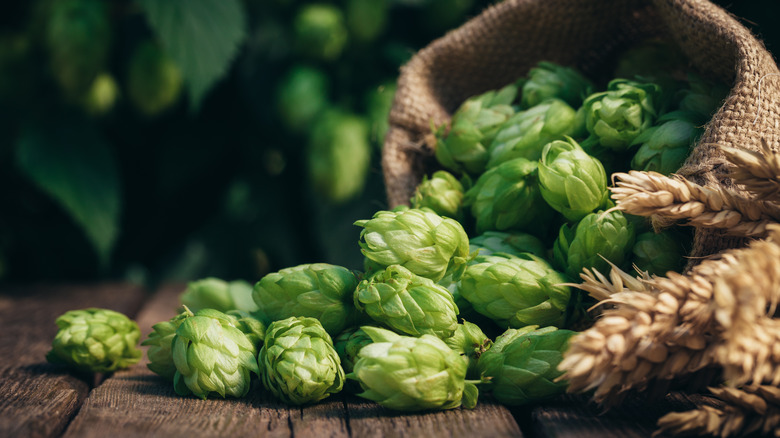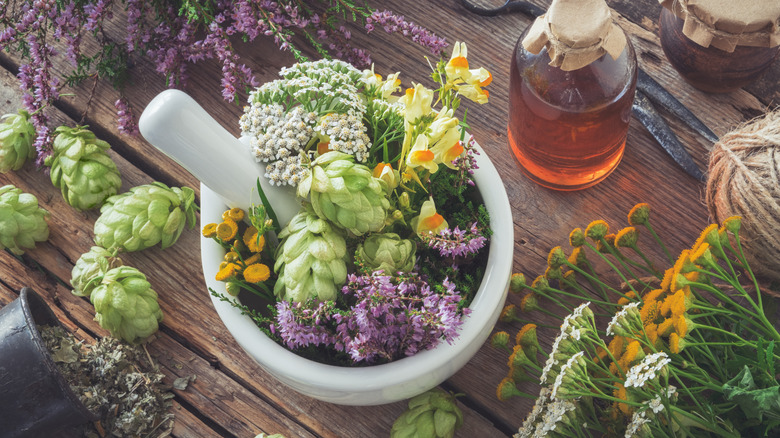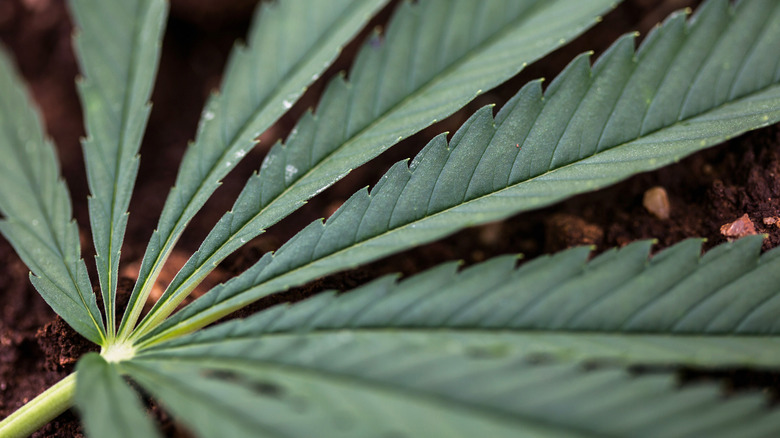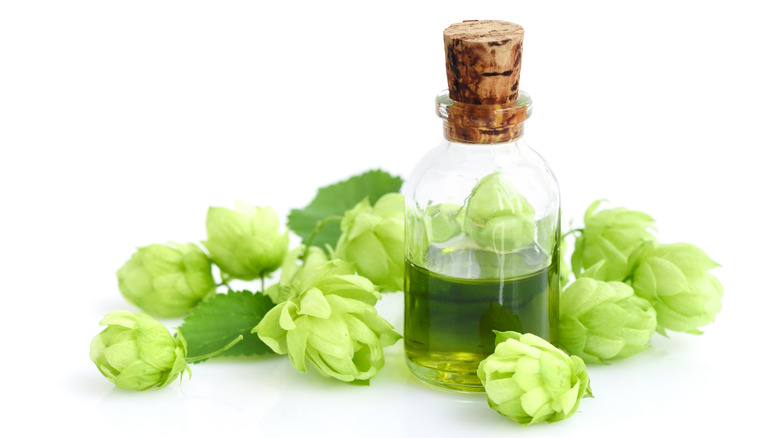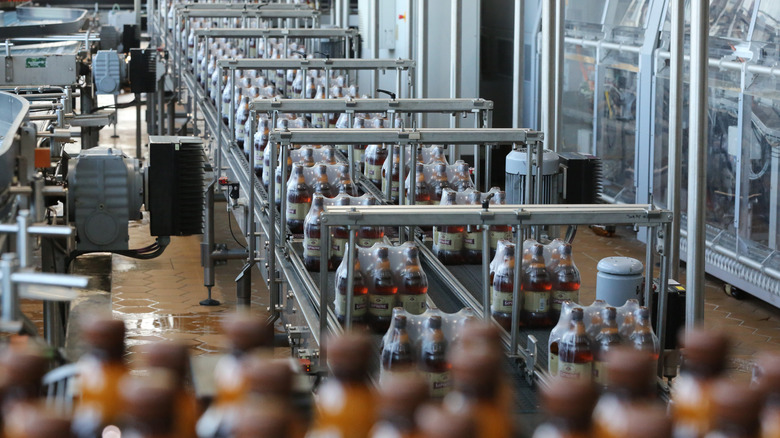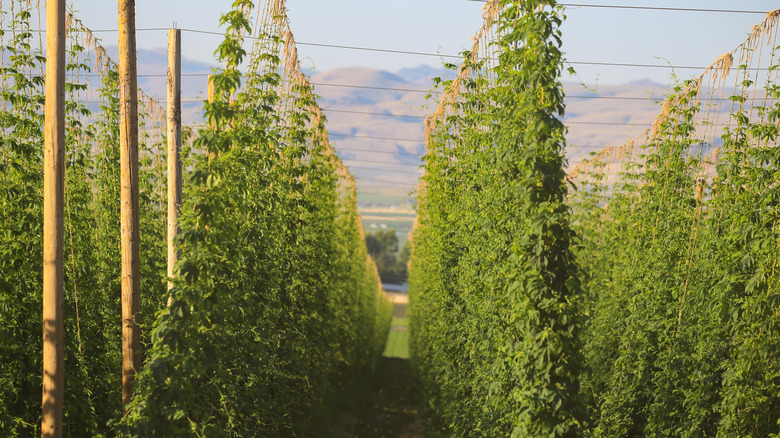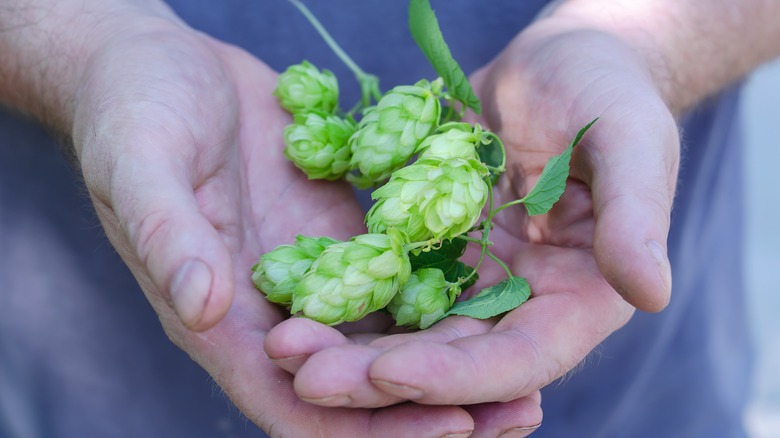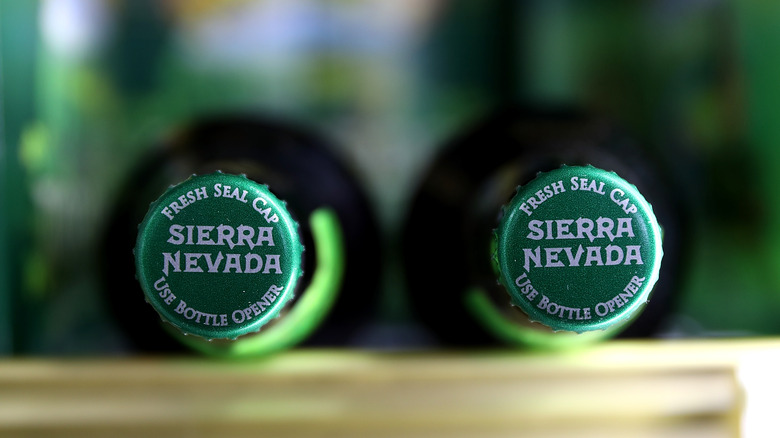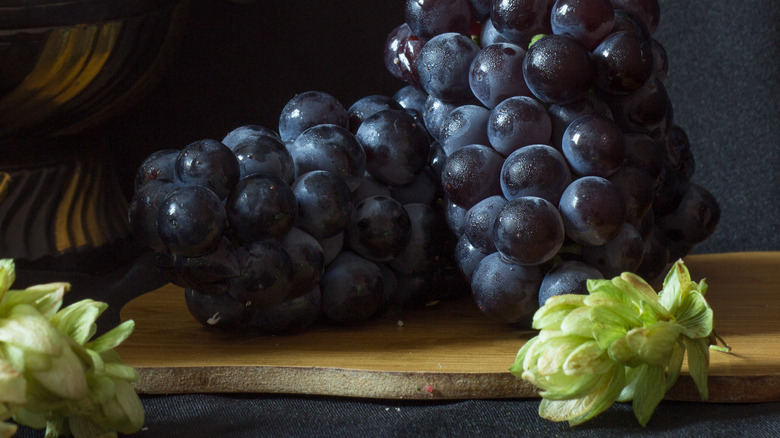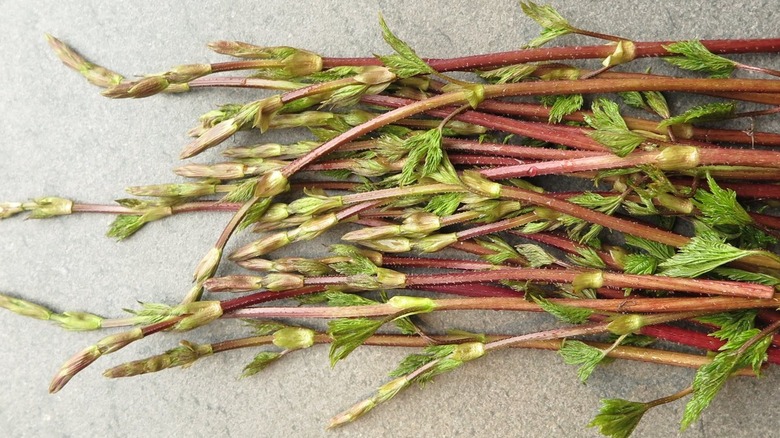The Untold Truth Of Hops
Although they may look like soft green pine cones, hops are in fact edible flowers, and as such form part of an illustrious culinary and social history. This history began with ancient civilisations from across the continents, such as the Aztecs, Ancient Greeks and Hindus, all of whom used flowers in numerous different circumstances, per Artisans and Adventurers.
Of course, nowadays hops are most famously associated with the beer brewing process, where their inclusion imparts a bitter taste that has become synonymous with the beverage. Yet, hops have so many uses that extend beyond just the production of beer. In recent history they have been used medicinally for their anti-inflammatory properties. Despite being the ugly duckling of edible flowers, hops have also been associated with spirituality and herbalism where their calming effects have been noted to benefit people suffering from anxiety and insomnia.
With American craft beer sales soaring by 8% in 2021, there is a steadily increasing respect for hops and the complex flavors they provide. However, general understanding of this fascinating flower — and the plant it comes from — still remains somewhat lacking. Read on to discover more about these often-overlooked flowers and understand why their impact goes so far beyond the creation of bitter beer.
Hops weren't always used in beer
Imagining beer without hops is like trying to picture New York without the Empire State building, or Italian cuisine before the invention of puttanesca; you know it must have existed at one time but imagining it just feels... weird. But as Smithsonian Magazine recounts, the now ubiquitous marriage of hops and beer did not come to pass until the 8th century, many millennia after the drink was first brewed
As with many alcoholic innovations we have religion to thank for this timely invention. Per author Steve Moretti, it was a group of Germanic, Benedictine monks who decided to add bitter wild hops to their beer. The addition of hops was an important milestone for the production of beer as it provided both balance to a drink which without added ingredients was extremely sweet, and a means of impeding the breakdown of beer by various bacteria. Despite the myriad superiorities that beer produced with hops had when compared to its non-hopped counterpart, the practice of adding hops during the brewing process still took a while to catch on. According to the British Hop Association, by the 17th century hopped beer had become the norm in the U.K. and other European countries. Brewing in early colonial America — which, according to Beer and Brewing, was also occurring around this time — also frequently included the incorporation of hops, these being a mixture of wild, domestically grown, and imported varieties.
Before hops brewers would use herbs to flavor beer
A practice that spans over 10,000 years, brewing has formed a part of countless, disparate societies across the globe. This is mainly because of beer's adaptability; it can be made by combining any type of grain with two globally prevalent ingredients: yeast and water. But whilst ancient beer was made with a variety of grains and in a number of ways, many societies found themselves with the same problem; their beverage was unbalanced and excessively sweet due to the process of fermentation, per Black Tail NYC.
Adding balance to beer was a must, and according to The Guardian, before the realization that hops could be used, many turned to gruit, a universal term for a collection of herbs, spices and other ingredients used to add bitterness to beer. Just like the availability of grain influenced the type of beer that could be produced, the abundance of indigenous herbs shaped how the beer would be flavored. For example, a Finnish beer called sahti was flavored using the twigs and berries of the juniper tree, per Science Daily; according to All About Beer Magazine, the appetizingly named bog myrtle was widely utilized to flavor beer across the rest of Europe.
Hops were originally used as medicine
With native hops being commonplace across much of the Northern Hemisphere, it can be assumed that multiple societies throughout history utilized the flower for their own medicinal needs. However, the most prolific record of hops being used as medicine comes from the indigenous nations of North America. Here, according to Master Brewers Association of the Americas, hops were utilized to treat a variety of ailments including toothache, colds, and sleep disorders across numerous, pre-colonial First Nation societies.
The medicinal use of hops was also discovered in the Arabic world, where written records from the 11th century attests to the potency of the flower, per Master Brewers Association of the Americas. Yet, as the American Botanical Council recounts, hops struggled to gain popularity as a medicine in Europe whilst gruit was still commonly used in beer. However, as hops slowly began to replace gruit, further attention was drawn to the flower's medicinal properties. Perhaps most famously hops began to be used to induce sleepiness. This was most often achieved by stuffing a pillowcase with dried hop cones; a method that was purportedly used by both King George III and Abraham Lincoln.
Hops belong to the same taxonomic family as cannabis
The ability of hops to act in this sedative nature becomes more understandable when you learn that the plant belongs to the Cannabaceae family, otherwise known as the hemp family. This taxonomic grouping also includes the sedative cannabis. As a result of their familial relationship, both hops and cannabis share a number of similarities, including taste and aroma.
As reported by Popular Science, these similar flavors and aromas are often attributed to the high number of terpenes (a type of organic compound) found in both plants. These terpenes — one of which is often called alpha acid when referring to hops — are the key reason why hops are added during the brewing process as it is these acids that carry the hops' distinctive bitter flavor. However, as Lagunitas points out, these terpenes alone do not cause psychoactive effects to occur when absorbed into the bloodstream and the absence of cannabinoids in hops ensures that ingesting or smoking the flower does not cause any of the effects associated with cannabis use.
Female hops are used for brewing
Another familiar feature of plants in the Cannabaceae family is that they are dioecious, which means that the plants have a specified, separate sex. These two varieties of hops, one male and the other female, grow on separate plants, with female plants only producing female flowers and vice versa. According to Beer & Brewing, as with most dioecious plants, reproduction naturally occurs when pollen from the male plant reaches the female plant, thus resulting in fertilization.
However, only female hops contain the lupulin glands that secrete alpha and beta acids; per Beer & Brewing, the two types of acid that make the plant desirable for brewing, along with essential oils that are responsible for a beer's aroma. Male hops' inability to produce these bitter tasting acids and oils makes them useless to brewers, and as such only female hops are widely cultivated. To get around the issue of reproduction the female hops are frequently cloned.
Essential hop oils are easily lost to oxidation
As previously stated, both alpha and beta acids are responsible for providing hops with their trademark bitter flavor. As such, through the careful manipulation of hops, their acids and essential oils, a beer recipe that matches the producer's desired flavor profile can be perfected. However, as reported by Love2Brew, alpha acids present within the beer slowly deteriorate with time, gradually worsening the beer's taste. Hypothetically, this should be mitigated by the more robust beta acids which can still lend the beer a degree of bitterness, although a flavor profile dominated by beta acids will be noticeably different to the beer's original taste.
Hops are also rich in essential oils. As More Beer notes, these compounds are primarily responsible for the hoppiness of a beer, as well as the aroma it emits. Unfortunately, just as a beer's bitterness can subside with time, its hoppiness can as well. That is because the essential oils, just like the alpha acids, are extremely susceptible to oxidation. As reported by Bräu Supply, the first port of call is to always store beer in a cool, dry environment. However, technology such as oxygen absorbing bottle caps are also commonly used. These caps seek to minimize oxygen being absorbed through the liners of the caps, a significant cause of oxidation that was highlighted way back in a 1988 issue of the Journal of American Society of Brewing Chemists.
The different flavor profiles of hops
With hops being rich in highly unique acids and oils, it should come as little surprise that the flavor of hops can vary greatly from variant to variant. Indeed, even hops of the same variant will taste significantly different given unique growing conditions, per Journal of The Institute of Brewing. Although hops can generally grow in most temperate climates, certain varieties will thrive in different conditions. This, along with a local populace that have acquired a taste for the flavors imparted by local hops, has led to specific varieties being associated with a geographic area or country.
British hops are typically described as earthy and herby in their flavor profile, characteristics that are thought to be primarily due to the low levels of sunlight they are exposed to, according to Foodism. As the outlet notes, this flavor profile is exemplified by England's most famous hop, East Kent Golding. Their American cousins are generally full of zingy citrus, with the Citra hop standing head and shoulders above the rest in this regard. However, in our contemporary, globalized world there is no longer any need to be constrained by distances or borders. As such, the brewers of today have unparalleled opportunity to create exciting beers by combining multiple hops from around the world.
The colonization of the U.S. led to new hops variants
When the English landed on the shores of what is today New England in the early 17th century, they brought with them hops to ensure a means of brewing beer, per Beer & Brewing. Unbeknownst to them, there were already three varieties of native hops present within the North American landmass. According to SFGate, one in particular, Humulus lupulus var. Lupuloides, which is found in the East of the continent, soon interbred with the imported English hops, creating wholly new and unique hop varieties.
These new varieties, which include Brewer's Gold and Cluster, heralded a new frontier for hops and brewing. A fact that American culture seemed to embrace until prohibition came into effect. As reported by Beer & Brewing, the Prohibition era decimated America's beer industry with over 85% of active brewers closing down. The difficulty of brewing home beer, as opposed to making bathtub gin meant that those who kept drinking generally drank spirits. As reported by Beer & Brewing, spirits constituted 75% of all alcohol drunk during this time. Even after the end of prohibition the effect of mass spirit consumption continued to influence brewing as the public's taste for complex beers had been almost completely lost. In an effort to rebuild, and reduce dependence on imported hops, The United States Department of Agriculture (USDA) launched a hop breeding program. This program has been responsible for an influx of new varieties, with many directly contributing to America's craft beer revolution.
America produces nearly one third of the world's hops
Beer has always been big business in America, and as a result the hop industry has been too. According to The Observatory of Economic Complexity, in 2020 America ranked as both the world's second largest exporter of hops and the world's largest importer of hops. America is also the world's largest hop grower, 40% of the world's hops are grown in this country, according to USA Hops, and harvests are generally increasing year on year, as is acreage.
This increase in brewing related agriculture is at odds with, as per JP Morgan's findings, a national — and global — stagnation in beer consumption. That is because craft beers, which are growing in popularity, utilize more hops throughout the brewing process than a simple lager does, according to Michigan State University. The demand for hops of new varieties has never been greater. As reported by Brewers Association, over one third of all hops produced are new varieties, and this demand is not expected to falter whilst the current craft beer craze continues.
The cascade hop is perhaps the most influential ever
In 1972, Cascade, a hop variety created by the USDA , was trialed by beer making giant Coors. Whilst ultimately this large scale brewer turned its back on the variety, other smaller brewers saw cascade's fantastic potential as a uniquely American hop. And unique it certainly was; during the '70s and '80s hop cultivation in America was predominantly focused on recreating well known European hops which could not have been more different to cascade's powerful taste, per Beervana.
The most famous champion of cascade is undoubtedly Ken Grossman, a brewer who used the then unknown hop to create a beer called Sierra Nevada pale ale. This craft beer stunned the American market, with its flavor and complexity standing in sharp contrast to the bland, uniform lagers that had been the country's main offering up to that point, and which remain prevalent today. Sierra Nevada pale ale soon became a bestseller, and has landed on a number of "best of" lists, including The Beer Connoisseur's ranking of top U.S. craft beers. However, the true success of the beer is not to be found in the accolades it has won for itself, but rather the attention it brought to great tasting craft beer made with uniquely American hops. What followed Sierra Nevada pale ale can only be described as an eruption in the popularity of American craft beer, and consequently, American hops. Per Market Data Forecast, the eruption of interest shows little sign of slowing.
Terroir affects hops as much as grapes
The prestige that drapes itself over vineyards and every other setting associated with winemaking is not one manufactured by mistake. Rather, it is the product of centuries worth of privilege, mystique, and inaccessibility that have been reinforced by exclusive settings where wine is portrayed as a drink for the higher classes. In contrast, beer and the process behind making it, despite the myriad complexities involved in both, are seen as more egalitarian; a drink and a drink making process suitable for all.
Due to the absence of pomp, many incorrectly make the assumption that beer — and consequently hops — are not complex enough to be influenced by the same nuances that create variety in wine and grapes. This simply is not the case. As revealed by Journal of The Institute of Brewing, hops are as affected by terroir (the environmental factors that affect a crop) as grapes are. The above study showed that the same variety of hops will produce significantly altered amounts of acids and essential oils when grown in different terroirs. Day length, and therefore latitude, also plays a uniquely important role in the development of hops, per Appellation Beer. All these factors combine to produce beers that widely differ in both aroma and taste, ensuring that beer can be just as, if not more, complex than wine.
Hops can be used in cooking
If hops are so rich in flavor that they revolutionized beer production it has to be asked why we rarely, if ever, see them advertised on a restaurant's food menu? The answer boils down to cost. The hops' early shoots — that are often cut back in order to leave space for the hardier, second sprouts — are a well-loved delicacy in Belgium, most often served with eggs and a sauce. Yet, the enormously labor intensive harvest means that these humble shoots are amongst the most expensive vegetables in the world, per Smithsonian Magazine.
In Italy, the vegetable, which goes by the name bruscandoli, is simultaneously foraged for by locals, and featured in Michelin star restaurants, where its flavor can catch unsuspecting diners by surprise. According to The Guardian, despite free shoots being given out as part of London's hop shoot festival, chefs and restaurateurs seem loath to become attached to a product that, according to Visit Flanders, can cost approximately €1000 per two pounds.
And whilst other, cheaper parts of the plant are edible, such as the flowers, the hops' distinct bitterness tends to be much more pronounced in these parts. There are some instances where these flowers can be used in cooking, as demonstrated by Bon Appétit. However, it is not a product which is expected to soar in popularity anytime soon, nor one we would hasten to recommend.
